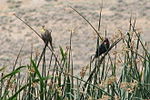Sierra Nevada Zoological Park
Buildings and structures in Reno, NevadaTourist attractions in Reno, NevadaZoo stubsZoos established in 1989Zoos in Nevada
The Sierra Nevada Zoological Park, formerly the Sierra Safari Zoo, is a zoo north of Reno, Nevada, United States. Opening in 1989, it has grown to become the zoo that houses more exotics in the state. The zoo houses a wide variety of exotic animals from around the world, including chimpanzees, gorillas, orangutans, big cats, reptiles, sloths, and others. The nonprofit zoo at times has received community support through in-kind donations such as meat from hunters to help support the animals in the zoo.
Excerpt from the Wikipedia article Sierra Nevada Zoological Park (License: CC BY-SA 3.0, Authors).Sierra Nevada Zoological Park
North Virginia Street, Reno
Geographical coordinates (GPS) Address Nearby Places Show on map
Geographical coordinates (GPS)
| Latitude | Longitude |
|---|---|
| N 39.6234 ° | E -119.9092 ° |
Address
Sierra Nevada Zoological Park
North Virginia Street 10200
89506 Reno
Nevada, United States
Open on Google Maps







